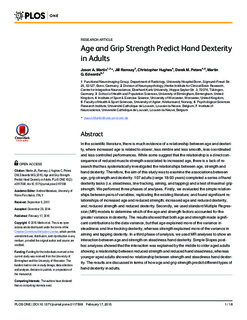| dc.description.abstract | In the scientific literature, there is much evidence of a relationship between age and dexterity,
where increased age is related to slower, less nimble and less smooth, less coordinated
and less controlled performances. While some suggest that the relationship is a direct consequence
of reduced muscle strength associated to increased age, there is a lack of research
that has systematically investigated the relationships between age, strength and
hand dexterity. Therefore, the aim of this study was to examine the associations between
age, grip strength and dexterity. 107 adults (range 18-93 years) completed a series of hand
dexterity tasks (i.e. steadiness, line tracking, aiming, and tapping) and a test of maximal grip
strength. We performed three phases of analyses. Firstly, we evaluated the simple relationships
between pairs of variables; replicating the existing literature; and found significant relationships
of increased age and reduced strength; increased age and reduced dexterity,
and; reduced strength and reduced dexterity. Secondly, we used standard Multiple Regression
(MR) models to determine which of the age and strength factors accounted for the
greater variance in dexterity. The results showed that both age and strength made significant
contributions to the data variance, but that age explained more of the variance in
steadiness and line tracking dexterity, whereas strength explained more of the variance in
aiming and tapping dexterity. In a third phase of analysis, we used MR analyses to show an
interaction between age and strength on steadiness hand dexterity. Simple Slopes posthoc
analyses showed that the interaction was explained by the middle to older aged adults
showing a relationship between reduced strength and reduced hand steadiness, whereas
younger aged adults showed no relationship between strength and steadiness hand dexterity.
The results are discussed in terms of how age and grip strength predict different types of
hand dexterity in adults. | nb_NO |
